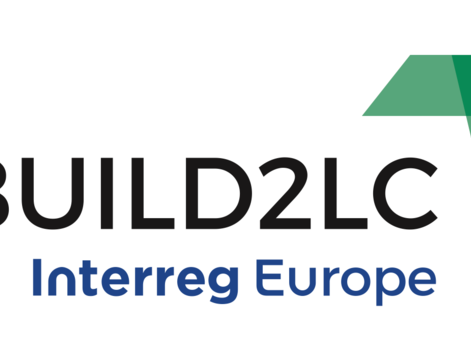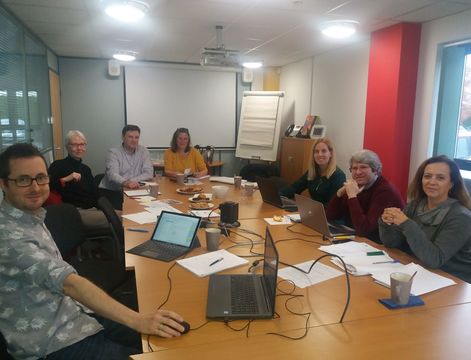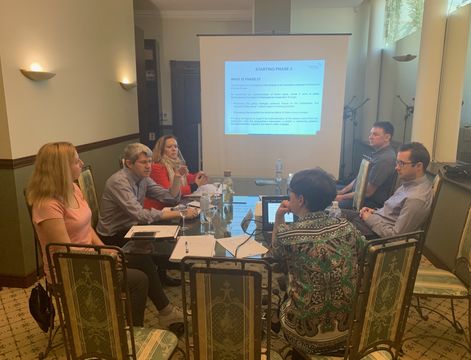
FIVE YEARS OF JOINT WORK OF BUILD2LC
FIVE YEARS OF JOINT WORK OF THE EUROPEAN BUILD2LC PROJECT
The recent framework strategy of the “Energy Union” of the European Commission indicates that 75% of European households are energy inefficient. There is also great potential for energy savings in public buildings of the EU. The BUILD2LC project will contribute decisively to achieve the EU energy goals, with its overall objective to increase the energy rehabilitation of buildings, and pave the path that facilitates the transit towards the new standard of nZEB buildings.
The key innovative aspect of BUILD2LC is its multidisciplinary approach, that counting on different complementary expertise at local (Gloucestershire County UK, and Gorenjska SI), regional (Andalusia ES, Rzeszow PL, North-West Croatia and Jämtland Region SE) and national (Lithuania) level, will allow achieving the energy goals and a sustainable development of the construction sector, based on improving the competitiveness, generating qualified employment, promoting innovation, and alleviating energy poverty, in line with the European objectives for smart, sustainable and inclusive growth.
The project with a high replicability impact will design innovative financial instruments, adapted to the needs of citizens, new mechanisms that contribute to a more competitive business network, special programmes to support innovation, and innovative collaboration actions, focusing on vulnerable groups. Home-owners, business sector, policy makers, local authorities, knowledge institutes and vulnerable groups will benefit from the project.
The project will develop a complete learning process to facilitate an effective knowledge flow among regions, with a bottom-up approach methodology, counting on the regional stakeholder groups. More than 70 best practices and almost 70 events involving nearly 400 stakeholders, will establish 7 Regional Action Plans covering a population of more than 15 million inhabitants and improving energy efficiency over 25% at the participating regions.
€1,622,547.00
Low-carbon economy
The key innovative aspect of the project is its multidisciplinary approach in the frame of the sustainable construction sector, including financial schemes, capacity building, innovation, awareness raising and combating against energy poverty, amongst others. It is necessary to progress simultaneously in all these fields to promote improved energy efficiency of buildings and consolidate a solid development of a business sector linked to energy rehabilitation.
The BUILD2LC project aims to ensure the real impact of the achievements in the long term, that will be achieve through new and innovative initiatives put in place, which will be adapted to the local needs and expectations of society.
All the participating regions have specific funds in their operative programme of ERDF funds for energy rehabilitation and energy planning tools with objectives set on energy efficency and renewable energy, ensuring the visibility of the improvements foreseen in the BUILD2LC project.
Objective: to improve energy efficiency and increase the use of renewable energy for electricity production and thermal uses in buildings
Characteristics: In the private field: a) incentives for the energy rehabilitation of buildings (residential and tertiary), prior energy audit and subsequent monitorisation; b) support for initiatives of business development associated to energy services. In the public field: a) investments in public buildings of the Andalusian Regional Government and municipalities, prior audit and subsequent monitorisation; b) high quality energy audits
Priority o Measure Concerned: The policy instrument addressed forms parts of regional energy strategies and planning of the Regional Government.
Reasons why it should be improved: The incentive model used at present in Andalusia has been based on incentives aimed at stimulating the demand of energy projects.
The new framework requires a reorientation of the previous model that together with energy saving and the reduction of emissions, allows better exploiting the opportunities of employment generation associated with energy rehabilitation and obtains a greater leverage of public funding. This will be achieved by introducing new financing instrument that facilitate the development of energy efficiency projects and additional measures aimed at business consolidation and development, the promotion of innovation and the attention to the vulnerable groups
Objective: to reduce energy consumption in public and multi-apartment buildings.
Characteristics: In the private field: incentives for the energy rehabilitation of multi-apartment buildings. In the public field: investments covering promotion of energy efficiency in public buildings.
Priority or Measure Concerned: The policy instrument is addressed to implement national energy strategies and to achieve the targets set by Directive 2012/27/EU. The investments in energy efficiency in public and multi-apartment buildings are in line with Lithuanian strategic documents, such as National Energy Independence Strategy and National Development Programme for 2014-2020 and Public Building Energy Efficiency Programme.
Reasons why it should be improved: In 2010, final energy consumption intensity was 21.5% lower than in 2000. However, energy consumption in Lithuania is still much higher than the average in the EU or old Member States. Renovation of multi-apartment and public buildings may achieve from 30 to 50% of the energy efficiency potential. A market failure in financing renovation of housing sector and public buildings in Lithuania is described in the Report of Ex Ante Assessment of Energy Efficiency (“Ex Ante Report”) approved on 7 November 2014 and demand for the renovation is up to 1752M EUR until 2023 according to the National energy strategy. The allocated financing for the public buildings and housing sector renovation sector is about 400M EUR.
Objective: There are two proposed investment areas under this thematic objective:
1) The flagship GREEN (Gloucestershire Renewable Energy) project to support renewable energy;
2) Demonstration and deployment of renewable technologies and approaches to businesses and households.
Characteristics: Contributing to European and national targets to reduce CO2 emissions.
• Building on the opportunity of low carbon energy generation.
• Addressing information and coordination failures in the labour market and the provision of skills to support the low carbon energy sector.
The policy seeks to build on previous and current activity that has supported energy efficiency. It directly references 3 core programmes previously delivered by Severn Wye (Link-to-Energy, Warm & Well, Target 2050 Exemplar programme) and encourages the progression of these through this strategy.
Priority or Measure Concerned: The primary priority is to include provision of support to the domestic & non-domestic sector for energy efficiency and renewable energy, and increasing skills within the region.
Reasons why it should be addressed: The emphasis for addressing climate change and supporting energy efficiency has weakened in recent years. The ESIF strategy provides a much needed impetus that will realise activity to support these aims, but further strategic support is required, which Build2LC provides to help define future activity and policy beyond 2020.
Objective: Supporting the transition to a low-carbon economy in all sectors
Characteristics: Deep modernisation of public buildings, deep modernisation of the energy residential buildings (multi-family residential buildings), introduction of energy management systems
Priority o Measure Concerned: The policy instrument addressed forms parts of regional energy strategies and planning of the Regional Government. Measures under this priority investment projects contribute also to achieving the objectives of the Europe 2020 strategy. The greatest potential in this respect is seen in public buildings and housing units, which account for 40% of final energy consumption and has a large untapped potential for cost-effective energy savings. The investments in energy efficiency in public and multi-apartment buildings are in line with Directive 2012/27 and the National Action Plan aimed at increasing the number of buildings with low energy consumption, in connection with Directive 2010/31 / EU.
Reasons why it should be improved: It is compatible with the Europe 2020 Strategy within the priority Sustainable development, the implementation of which will contribute to increase the share of renewables in the energy balance of the region, improve energy efficiency particularly in the public sector. The new approach requires not only reduction of emissions but also should concentrate on more opportunities of employment
Objective: to improve energy efficiency in the public sector and in households.
Characteristics: In the public field: a) energy savings in the building stock of the public sector; b) energy renovated floor area of buildings occupied or owned by the central government. In the private field: a) energy end-use savings in the household sector.
Priority or Measure Concerned: The policy instrument addressed forms parts of Action plan for energy efficiency, for renewable energy sources and for nearly zero energy buildings implemented by the Ministry of Infrastructure, Energy directorate.
Reasons why it should be improved: Promotion of actions to improve energy efficiency and use of renewable energy sources in the public and household sector and in enterprises is necessary in Slovenia, all the more so because the pressure of GHG emissions caused by transport persistently grows. If Slovenia wants to achieve the national obligations under the climate package by 2020, it will have to develop an ambitious programme of national measures for energy efficiency and renewable energy sources. Legislation in Slovenia on implementing public private partnerships with new financing schemes is very complicated and is the main reason that there are no more of this kind of projects. Lack of involvement of construction clusters with innovative approaches and innovative financial schemes resulted in significant increase of energy poverty in old city centres that are cultural heritage protected.
Objective: to improve energy efficiency and increase the use of renewable energy for electricity production and thermal uses in buildings.
Characteristics: It was recognized that the largest savings (34%) can be achieved in the residential sector. The increasing share of renewable energy in energy use, with a particular focus on providing Independent solutions for energy supply, will contribute to achieving the national goals which relate to the production of electricity, in particular for the production of energy for heating / cooling. Similarly, investment in corresponding improvement of public energy infrastructure will contribute to a more efficient the use of energy sources.
Priority or Measure Concerned: The policy instrument addressed forms parts of regional energy strategies and planning of the Regional Government. Also it is important to mention that, besides already mentioned Operational Programme, Croatian Government also adopted several documents regarding energy efficiency in building sector.
Reasons why it should be addressed: Even though in Croatia there are several legal document related to energy efficiency in the building sector, the implementation is going rather slow and it is necessary to take some measures which will accelerate the process of implementation. This will be achieved by implementation of new projects and introducing new financing instruments as well as the promotion of innovation and raising awareness among related interest groups.
Thematic Objective 4 - supporting the transition to a low-carbon economy in all sectors
Advice to companies and the public sector is expected to provide reduced energy and reduced climate impact. It is important that this work continues and reaches new companies.
Collaboration on joint solutions where companies benefit from each other's activities should be supported. This can involve issues concerning energy, utilisation of waste products, and more. Producing renewable materials for housing sector needs to be utilised to a greater extent than today, therefore prioritised actions encourage sustainable building, favours the regional industry in the programme area and reduces climate impact. One way to achieve energy savings and develop energy efficient products and services is green procurement. Knowledge of how this facility can be used as policy instruments needs to be strengthened in both the public and private sector.
Improvement of the policy instrument is made through work within the Regional Development Strategy, that is the basic instrument behind the Operational programme.

FIVE YEARS OF JOINT WORK OF THE EUROPEAN BUILD2LC PROJECT

BUILD2LC “Boosting Low Carbon Innovative Building Rehabilitation in European Regions”, ON- LINE FINAL MEETING

BUILD2LC online project meeting - mini session on Innovation 5th November 2020

BUILD2LC online project meeting - mini session on new energy culture

BUILD2LC online project meeting - mini session on professionalisation of construction sector

BUILD2LC online project meeting - mini session on financial instruments

BUILD2LC project online partner meeting

BUILD2LC project online partner meeting

BUILD2LC project partner meeting in Gloucester - Action plans coordination meeting

Action Plans Coordination meeting of the BUILD2LC project